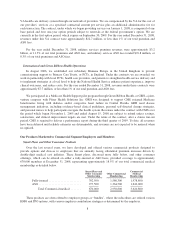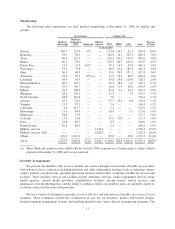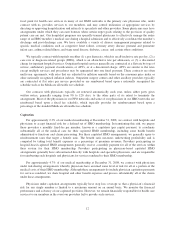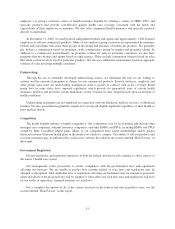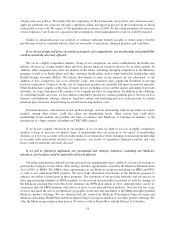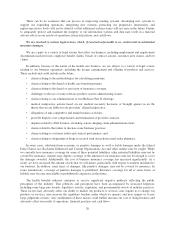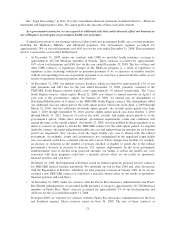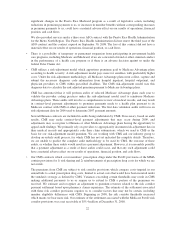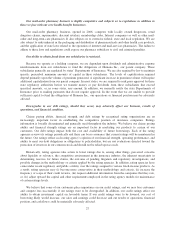Humana 2008 Annual Report Download - page 27
Download and view the complete annual report
Please find page 27 of the 2008 Humana annual report below. You can navigate through the pages in the report by either clicking on the pages listed below, or by using the keyword search tool below to find specific information within the annual report.ITEM 1A. RISK FACTORS
If the premiums we charge are insufficient to cover the cost of health care services delivered to our
members, or if our estimates of benefits payable or future policy benefits payable based upon our estimates of
future benefit claims are inadequate, our profitability could be materially adversely affected.
We use a substantial portion of our revenues to pay the costs of health care services delivered to our
members. These costs include claims payments, capitation payments, and various other costs incurred to provide
health insurance coverage to our members. These costs also include estimates of future payments to hospitals and
others for medical care provided to our members. Generally, premiums in the health care business are fixed for
one-year periods. Accordingly, costs we incur in excess of our benefit cost projections generally are not
recovered in the contract year through higher premiums. We estimate the costs of our future benefit claims and
other expenses using actuarial methods and assumptions based upon claim payment patterns, medical inflation,
historical developments, including claim inventory levels and claim receipt patterns, and other relevant factors.
We also record benefits payable for future payments. We continually review estimates of future payments
relating to benefit claims costs for services incurred in the current and prior periods and make necessary
adjustments to our reserves. However, these estimates involve extensive judgment, and have considerable
inherent variability that is sensitive to payment patterns and medical cost trends. Many factors may and often do
cause actual health care costs to exceed what was estimated and used to set our premiums. These factors may
include:
• increased use of medical facilities and services, including prescription drugs;
• increased cost of such services;
• our membership mix;
• variances in actual versus estimated levels of cost associated with new products, benefits or lines of
business, product changes or benefit level changes;
• changes in the demographic characteristics of an account or market;
• changes or reductions of our utilization management functions such as preauthorization of services,
concurrent review or requirements for physician referrals;
• possible changes in our pharmacy rebate program with drug manufacturers;
• catastrophes, including acts of terrorism, public health epidemics, or severe weather (e.g. hurricanes and
earthquakes);
• the introduction of new or costly treatments, including new technologies;
• medical cost inflation; and
• government mandated benefits or other regulatory changes.
In addition, we also estimate costs associated with long-duration insurance policies including life insurance,
annuities, health, and long-term care policies sold to individuals for which some of the premium received in the
earlier years is intended to pay anticipated benefits to be incurred in future years. These future policy benefit
reserves are recognized on a net level premium method based on interest rates, mortality, morbidity, withdrawal
and maintenance expense assumptions from published actuarial tables, modified based upon actual experience.
The basis for the liability for future policy benefits is established at the time each contract is acquired and would
only change if our experience deteriorates to the point the level of the liability is not adequate to provide for
future policy benefits. Future policy benefits payable include $503.2 million at December 31, 2008 associated
with a closed block of long-term care policies acquired in connection with the November 30, 2007 KMG
acquisition. Long-term care policies provide for long-duration coverage and, therefore, our actual claims
experience will emerge many years after assumptions have been established. The risk of a deviation of the actual
morbidity and mortality rates from those assumed in our reserves are particularly significant to our closed block
17



